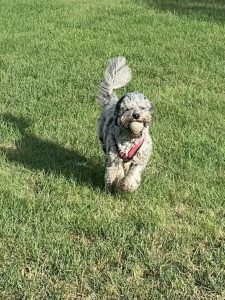
Keep our home environment safe for your Golden Mountain Doodle with less stress for you!
This post contains affiliate links. We appreciate your support of our site but of course, you may opt to view products and purchase elsewhere.
Table of Contents
Whether you’re bringing home a Golden Mountain Doodle puppy or have an adult dog, there are a few things you can attend to in your home environment that may make things more comfortable for both you and your pet.
Accommodating Work Schedules and Doggy "Alone Time"
The Golden Mountain Doodle is a very sociable breed and prefers to be around people. If they spend a great deal of time alone due to an owner’s work schedule, it’s a good idea to think about how you can accommodate your dog. A dog that spends too much time alone can become anxious, overly energetic, or destructive. This certainly makes the time that you do spend with your dog more difficult.
This doesn’t mean that your dog can’t spend time by him or herself, but it does mean that they need regular attention and social interaction. Some people who are juggling work schedules with the responsibilities of pet ownership opt for full- or part-time doggy day care or have a doggy caregiver drop in once a day or a few times a week to let a dog out to go potty and run around outside.
Many people choose to crate their dog during times when they do not have supervision; however, for an extended time period, you should consider gating off a “safe” area of your home so that your dog has space to play, sleep, and eat. If they do not have a dog door or access to the outdoors, you may want to consider introducing an appropriately-sized astro-turf potty system for your dog to use when left alone. Alternatively, a pet sitter who can drop in, even briefly, may be an option.
Make sure your dog’s “safe zone” is free of garbage cans (which many dogs love to get into), and socks and other laundry (which are a favorite of many Doodles and very dangerous if/when swallowed). If your dog is a chewer, watch for cords and other items that they may find tempting.
When it’s time to leave your dog, some trainers recommend leaving them with a filled Kong or other preferred chew. This serves both as a pleasant distraction and for mental stimulation. The environment should also include interactive play options, if possible, especially if your absence will be longer-term (think treat ball, Bob-a-Lot, or the Wobble, Wag, Giggle).
Some people who need to leave a dog alone for extended periods get a “puppy for their puppy,” which can help fill the need for both socialization and play.
And the Opposite Problem, too many People!
On the other end of the spectrum are dogs in a home with lots of people (particularly children) consistently present. Just like people, dogs sometimes need a break from the action and a quiet place to get away. A dog sleeping on the couch or floor may not react favorably to being unsuspectingly jumped on by a child who decides it is play time.
Even if you do not typically use a crate, it’s a good idea to set up a crate for your dog in an out-of-the-way place and leave the door always open for them. Keep a comfy mat or blanket and a few chew toys in there. Encourage them to go in when they feel sleepy or want to lay down with a chew toy. Eventually they will know it’s a place to relax and get away, and they will go there independently. Make this a “no-go zone” for children and teach them to respect your dog’s desire for peace and quiet. (And, yes, many parents wish they could do this themselves, right?!)
Staying Clear of Potential Health Hazards
As already mentioned, Doodles are unfortunately known for their propensity to chew socks, underwear, and other items that can cause a very serious bowel obstruction if/when swallowed.[1] While you can train your dog to “leave it,” that doesn’t completely eliminate the temptation, and if you’re not around to command good behavior, you may have an emergency on your hands.
In the case of socks and other items that can be hazardous (small toys, in particular, if you have children) it is often easier to train the people than the dog. Children and adults alike can be encouraged to pick up any items carelessly left on the floor. This goes for shoes as well, which may not be hazardous but can be a dog’s favorite chew item.
Having a puppy, or even an adult dog, can be a lot like having a baby or toddler in the house. Exercise caution when storing chemicals and cleaners that can be hazardous to your dog (even “natural” things like diatomaceous earth). Everyday foods that are not safe or recommended for dogs include onions, grapes, chocolate, raisins, spinach, and alcohol.[2]
Beneficial Exercise/Play and Training Routines
As a mixed breed with intelligent and working dogs in their lineage, Golden Mountain Doodles benefit from an environment that offers consistent exercise, play, basic training, and stimulating toys. A GMD owner should take all of this into consideration when setting up an environment and a routine for their dog.
Daily training sessions, as short as 5-10 minutes, are helpful, even if the only commands your dog knows are “come,” “sit,” and “stay.” Putting them through a few paces helps them feel productive and goes a long way in reducing undesirable behaviors.
Many dogs enjoy fetch, Frisbee, or ball, and can expend a lot of energy quickly with an impromptu play session. (We offer some suggestions for recommended play toys if you’re looking.)
A fenced yard can give a dog space to roam, but the social aspect of taking a walk appeals to some dogs more than romping around an empty yard alone. Be sure your dog gets targeted exercise each day. The recommended amount varies, but at least 30 minutes in the morning and evening is a suggested minimum. If you are going to leave your dog for an extended period, a play period or walk just before leaving can help limit any anxious or destructive behaviors when your dog is alone.
Chew toys provide a great deal of stimulation for dogs, as do slow feeders, lick mats, and other food-based activities. Offer your dog a variety of toys for chewing and for more active play, as well as those that promote mental stimulation. However, remember that a dog with too many options can quickly become over-stimulated or end up unable to choose or appreciate a specific toy. You may want to rotate chew and play toys to keep things fresh for your puppy.
Providing the best possible environment for your GMD goes a long way in minimizing stressors and ensuring that your dog is a happy, healthy companion pet for many years to come.

